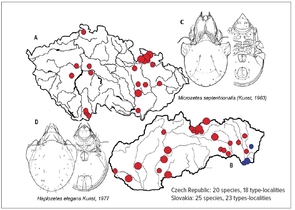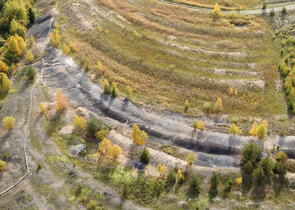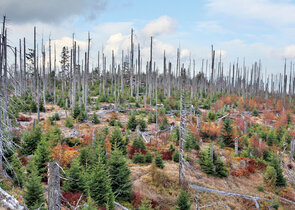Soil as a Biodiversity Hotspot, Namely that of Small Soil Arthropods

When presenting examples of particularly species-rich ecosystems, we will most probably name tropical coral reefs, tropical gallery forests or selected types of tropical rainforests. To visit these ecosystems, one must travel a long journey far outside of homeland, and even beyond borders of our continent. Still, a comparably species-rich ecosystem can be found, even in our conditions – yet escaping broader awareness when speaking about biodiversity. This is perhaps caused by simple fact, that thousands of species inhabiting this ecosystem could only rarely be observed by the naked eye, as they are mostly of the microscopic size. Indeed, healthy, and well-functioning soil – in our conditions mostly soil of broad-leaved deciduous or mixed forests – is a real biodiversity hotspot reachable just “beyond our courtyards” or next door. Presence of the particular species, overall species richness and relative numbers of soil organisms serves at the same time as great indicator of soil conditions, and often also of the quality of respective above-ground ecosystem at the place.
Nature Conservation 2022 — 25. 5. 2022 — On Nature in the Czech Republic — Print article in pdf
The Landscape of Cooperation – Forty Years of the Bílé Karpaty/White Carpathians Mts. Protected Land

What comes to mind when you hear the word the Bílé Karpaty/White Carpathians Mts.? A hundred years ago it was still the most remote corner of the Czech Republic, from which people were leaving for America to find a job. Today it is a popular destination for an increasing number of visitors of the entire country. Everyone will come up with something else – probably most often meadows full of orchids stretching to the horizon, but also (from west to east) wine cellars near the municipality of Petrov and the town of Strážnice, old service/sorb trees (Sorbus domestica), the Horňácko/Upper Moravian Slovakia region folk culture, the Moravian Kopanice region with the Goddesses of Žítková, the virgin forest below the top of Mt. Velká Javořina/Great Maple Forest, beech forests in the Vlára Pass, or the well-preserved landscape of Southern Moravian Wallachia around the municipality of Nedašov. The landscape and nature of the picturesque mountains on the Slovak border has really extremely many faces.
Nature Conservation 2022 — 25. 5. 2022 — On Nature in the Czech Republic — Print article in pdf
What Attract Rare Invertebrates to Brown Coal Spoil Heaps?

The lunar landscape image of coalmine regions keeps clinging to people’s minds, despite the fact that a lot of good has happened since the boom of brown coal surface mining below the Krušné hory/Ore Mountains (northwestern Bohemia). Mining companies are in good faith fulfilling their mining obligations including the reclamation of spoil heaps and residue pits in extensive surface quarries as is imposed by law, primarily the Mining Act, the Forest Act and the Act on the Protection of Agricultural Land. An area of more than 12,000 hectares has already been technologically and biologically reclaimed, and at least CZK 20 billion (EUR 0.8 billion) have been invested there (figure converted to today’s value of the Czech Crown based on common reclamation prices) from the miners’ financial reserves as well as governmental resources (see www.15miliard.cz).
Nature Conservation 2022 — 25. 5. 2022 — On Nature in the Czech Republic — Print article in pdf
Which Forest Is Formed by Spontaneous Processes in the Šumava/Bohemian Forest Mts.?

The thirty years of the Šumava/Bohemian Forest Mts. National Park (NP) have provided many findings – due to natural disturbances. European spruce bark beetle (Ips typographus) outbreaks culminated in 1996–1997 and 2009–2010, leading to a mass Norway spruce (Picea abies) decline in 1997 and 2011. But the European spruce bark beetle has left its traces until today, although to a lesser extent, just like a range of hurricanes. The result is that a quarter of the NP’s non-intervention area (approx. 18,000 hectares until 2019) is formed by stands with dead trees. Non-forest areas and peat-bogs account for about 22% and variously old stands dominated by spruce for the remaining 53%. The world of large spruce temples with tall column trunks has changed rapidly in a part of the territory.
Nature Conservation 2022 — 25. 5. 2022 — On Nature in the Czech Republic — Print article in pdf
Uranium Spoil Heaps near the Town of Příbram as a Part of Cultural Landscape Heritage and a Threaten

Mineral mining has had a long tradition as an important national economy sector in the Czech Republic. Sites disturbed by mining have become an integral part of the landscape in many regions. The most altered sites include quarries, dumps and heaps, sand- and gravel pits, kaolin mining sites, and slag and fly ash tailing ponds. The traditional negative view of sites affected this way has rapidly been changingamong experts. Early successional (development) stages and diverse habitats with extreme conditions and low productivity, common at such sites, often serve as substitute habitats for many species disappearing from the landscape in the Czech Republic. Several studies demonstrating the considerable conservation potential of these sites come from the Czech Republic.
Nature Conservation 2022 — 25. 5. 2022 — On Nature in the Czech Republic — Print article in pdf
The Jizerskohorské bučiny / Jizera Mountains Beech Forest National Nature Reserve – A Part of the Wo

It would not be far from the truth to say that in summer 2021 the Jizerské hory/Jizera Mountains Beech Forest National Nature Reserve (NNR) became the most often mentioned Specially Protected Area in mass media in the Czech Republic. In July 2021, the NNR was inscribed on the prestigious UNESCO World Heritage List becoming a new component of the serial World Heritage Site Ancient and Primeval Beech Forests of the Carpathians and Other Regions of Europe (Plesník & Hušek 2021). Because in previous articles we have provided only a brief description of the NNR and have paid attention more to its nomination and approval (Plesník & Hušek 2020, Plesník 2020) it is quite appropriate to present the extraordinary site not only from a point of view of nature and landscape heritage protection, conservation and management in more detail.
Nature Conservation 2022 — 25. 5. 2022 — On Nature in the Czech Republic — Print article in pdf

